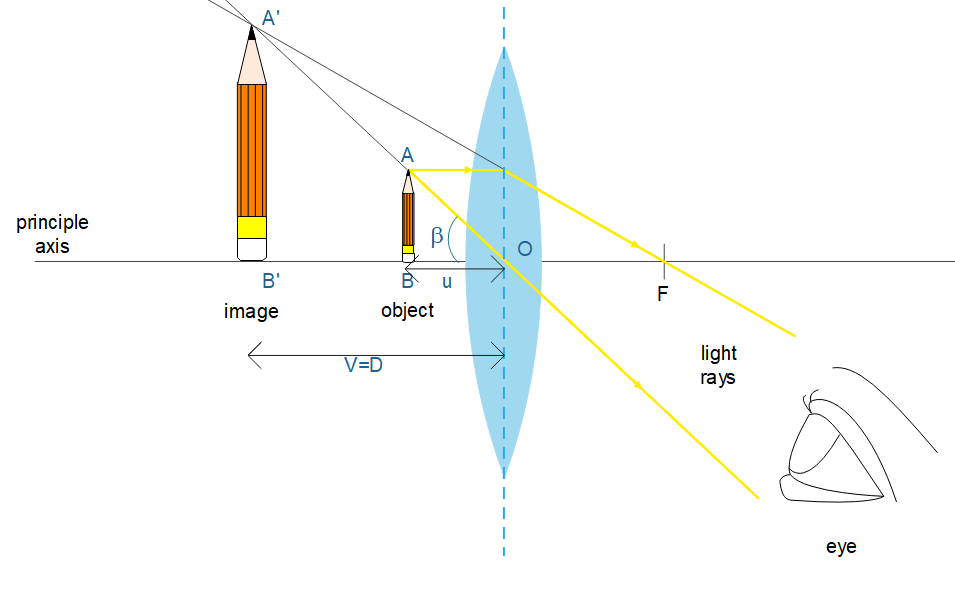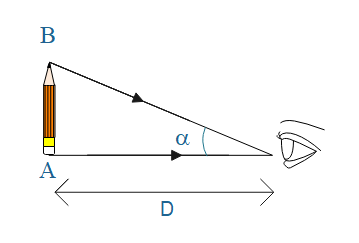
Explain simple microscope on the basis of the following points:
(a) Ray diagram for the formation of image;
(b) Expression for magnifying power when the final image is formed: (i) At the least distance of distinct vision; (ii) At infinity.
Answer
585k+ views
Hint: Lens used in a simple microscope is a convex lens, it forms a virtual, erect and magnified image at distance of distinct vision. In this way you can imagine a diagram by knowing the idea of a convex lens. Magnifying power is defined as ratio of angle subtended at eye by the image and angle subtended at unaided eye by the object at distance of distinct vision. Put the values in magnifying power formula and get magnifying power formula for image at DDV and image at infinity.
Complete step by step answer:


The magnifying power of a simple microscope is defined as the ratio of the angle subtended at eye by the image to the angle subtended at unaided eye by the object kept at distance of distinct image (DDV).
$\begin{align}
& \text{M}\text{.P}\text{. =}\dfrac{\text{angle subtended at eye by the image}}{\text{Angle subtended at unaided eye by the object at DDV}} \\
& \text{M}\text{.P}\text{. =}\dfrac{\beta }{\alpha }----(1) \\
\end{align}$
Where $\beta $ is the angle subtended at the eye by the image\[A'B'\]and$\alpha $is the angle subtended at the eye by the object kept at DDV.
\[\begin{align}
& \text{Consider }\vartriangle \text{A }\!\!'\!\!\text{ B }\!\!'\!\!\text{ O,} \\
& \text{tan}\beta \text{=}\dfrac{A'B'}{OB'}=\dfrac{AB}{u} \\
& \text{since}\beta \text{ is very small-tan}\beta \approx \text{ }\beta \text{=}\dfrac{AB}{u} \\
\end{align}\]
\[\begin{align}
& \text{tan}\alpha \text{=}\dfrac{AB}{D} \\
& \text{since}\alpha \text{ is very small-tan}\alpha \approx \alpha \text{=}\dfrac{AB}{D} \\
\end{align}\]
Put value in equation (1), we get
$M.P.=\dfrac{\dfrac{AB}{u}}{\dfrac{AB}{D}}=\dfrac{D}{u}$
From lens formula we have: $\dfrac{1}{v}-\dfrac{1}{u}=\dfrac{1}{f}$
According to sign convention. Here $u\text{ and }v$ are negative and $f$is positive,
Therefore we get-
$\begin{align}
& \dfrac{1}{u}=\dfrac{1}{v}+\dfrac{1}{f} \\
& \dfrac{D}{u}=\dfrac{D}{v}+\dfrac{D}{f} \\
& M.P.=\dfrac{D}{v}+\dfrac{D}{f} \\
\end{align}$
This equation gives the magnifying power of a simple microscope.
Case (i): If the image is formed at distance of distinct vision i.e. DDV i.e\[v=D\], then
$M.P.=\dfrac{D}{D}+\dfrac{D}{f}=\left( 1+\dfrac{D}{f} \right)$
Hence magnifying power is $\left( 1+\dfrac{D}{f} \right)$, if the image formed at distance of distinct vision.
Case (ii): If the image is formed at infinity i.e. $v=\infty ;$then
$M.P.=\dfrac{D}{\infty }+\dfrac{D}{f}=\left( \dfrac{D}{f} \right)$
Hence magnifying power is $\dfrac{D}{f}$, if the image formed at infinity.
Note:
From above two cases, we can say that magnifying power of simple microscope can be anything from$\left( \dfrac{D}{f} \right)to\left( 1+\dfrac{D}{f} \right)$.
Thus the magnifying power of a simple microscope is inversely proportional to focal length and it is maximum when the image is at a distance of distinct vision.
Complete step by step answer:


The magnifying power of a simple microscope is defined as the ratio of the angle subtended at eye by the image to the angle subtended at unaided eye by the object kept at distance of distinct image (DDV).
$\begin{align}
& \text{M}\text{.P}\text{. =}\dfrac{\text{angle subtended at eye by the image}}{\text{Angle subtended at unaided eye by the object at DDV}} \\
& \text{M}\text{.P}\text{. =}\dfrac{\beta }{\alpha }----(1) \\
\end{align}$
Where $\beta $ is the angle subtended at the eye by the image\[A'B'\]and$\alpha $is the angle subtended at the eye by the object kept at DDV.
\[\begin{align}
& \text{Consider }\vartriangle \text{A }\!\!'\!\!\text{ B }\!\!'\!\!\text{ O,} \\
& \text{tan}\beta \text{=}\dfrac{A'B'}{OB'}=\dfrac{AB}{u} \\
& \text{since}\beta \text{ is very small-tan}\beta \approx \text{ }\beta \text{=}\dfrac{AB}{u} \\
\end{align}\]
\[\begin{align}
& \text{tan}\alpha \text{=}\dfrac{AB}{D} \\
& \text{since}\alpha \text{ is very small-tan}\alpha \approx \alpha \text{=}\dfrac{AB}{D} \\
\end{align}\]
Put value in equation (1), we get
$M.P.=\dfrac{\dfrac{AB}{u}}{\dfrac{AB}{D}}=\dfrac{D}{u}$
From lens formula we have: $\dfrac{1}{v}-\dfrac{1}{u}=\dfrac{1}{f}$
According to sign convention. Here $u\text{ and }v$ are negative and $f$is positive,
Therefore we get-
$\begin{align}
& \dfrac{1}{u}=\dfrac{1}{v}+\dfrac{1}{f} \\
& \dfrac{D}{u}=\dfrac{D}{v}+\dfrac{D}{f} \\
& M.P.=\dfrac{D}{v}+\dfrac{D}{f} \\
\end{align}$
This equation gives the magnifying power of a simple microscope.
Case (i): If the image is formed at distance of distinct vision i.e. DDV i.e\[v=D\], then
$M.P.=\dfrac{D}{D}+\dfrac{D}{f}=\left( 1+\dfrac{D}{f} \right)$
Hence magnifying power is $\left( 1+\dfrac{D}{f} \right)$, if the image formed at distance of distinct vision.
Case (ii): If the image is formed at infinity i.e. $v=\infty ;$then
$M.P.=\dfrac{D}{\infty }+\dfrac{D}{f}=\left( \dfrac{D}{f} \right)$
Hence magnifying power is $\dfrac{D}{f}$, if the image formed at infinity.
Note:
From above two cases, we can say that magnifying power of simple microscope can be anything from$\left( \dfrac{D}{f} \right)to\left( 1+\dfrac{D}{f} \right)$.
Thus the magnifying power of a simple microscope is inversely proportional to focal length and it is maximum when the image is at a distance of distinct vision.
Recently Updated Pages
A man running at a speed 5 ms is viewed in the side class 12 physics CBSE

State and explain Hardy Weinbergs Principle class 12 biology CBSE

Which of the following statements is wrong a Amnion class 12 biology CBSE

Two Planoconcave lenses 1 and 2 of glass of refractive class 12 physics CBSE

The compound 2 methyl 2 butene on reaction with NaIO4 class 12 chemistry CBSE

Bacterial cell wall is made up of A Cellulose B Hemicellulose class 12 biology CBSE

Trending doubts
What are the major means of transport Explain each class 12 social science CBSE

Which are the Top 10 Largest Countries of the World?

Draw a labelled sketch of the human eye class 12 physics CBSE

State the principle of an ac generator and explain class 12 physics CBSE

Sketch the electric field lines in case of an electric class 12 physics CBSE

Give 10 examples of unisexual and bisexual flowers




